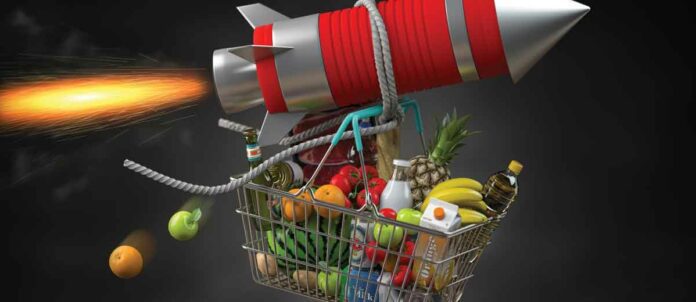For the last few years, the foodservice industry has been defined by disruption, a large portion of which can be tied to a complex network of supply-chain challenges.
As Sylvain Charlebois, director, Agri-Food Analytics Lab, Dalhousie University notes, operators want prices and timelines to be predictable, but right now, they simply aren’t.
“We’re seeing some ingredients double in price in recent months. So, as an operator, you wonder how to cope with that. And, if you don’t buy it, it may actually require you to re-design your menu,” he adds. “You’re being asked by suppliers to pay more for certain products for a variety of reasons and making sense of the whys is difficult because there are all sorts of challenges happening across the supply chain that are pushing prices higher.”
In many cases, it’s a number of disparate factors coming together to create this effect. As an example, Dave Iacobelli, Chief Commercial Officer of Kitchener, Ont.-based Flanagan Foodservice points to struggles getting product from some of the big beverage companies, the root of which had less to do with the beverage products themselves and more to do with packaging, such as bottle caps and aluminum cans.
Providing further insight, Garett Senez, VP Marketing, at Vancouver-based craft-beer, wine and spirits distributor PACRIM Distributors, notes prices for cans are up 40 per cent and the price of boxes/cases is up 60 per cent.
There’s also the issues caused by the war in the Ukraine and the ongoing drought in California, impacting products such as seafood and produce respectively.
However, Iacobelli notes the challenges faced by Flanagan — and the supply chain more broadly — can be roughly summed up in two categories: shortages and inflationary cost pressures. “[There’s] just an overall shortage across multiple facets,” he explains, noting labour shortages, product availability and equipment shortages. And on the cost front, he adds, “We’ve seen cost spikes across labour, fuel, equipment (whether it purchasing or leasing that equipment), shipping-container costs, utility [and] insurance costs.”
All of these factors are forcing operators, suppliers and producers to examine and evolve their operations to a degree. As an example, Senez points out that current conditions have actually contributed to the boom in the hard-seltzer market. While many brands originally jumped on the wagon and began producing them because it was a trendy product, “now people are producing [hard seltzers] because of cost economics, because it’s expensive to brew beer,” he explains.
“The cost of malt is going up, particularly out of Europe, and a lot of the hops and malt is actually imported,” Senez shares. And, given there’s a ceiling on the price Canadian consumers are willing to pay for a bottle of beer, “Brewers have to get resourceful. They have to either cut the quality of ingredients or resource different ingredients from different areas.”
Similarly, restaurants have had to adjust menus, limiting or eliminating items that cannot be sourced reliably or have simply become too expensive to be sustainable. Items such as halibut, calamari, iceberg lettuce and romaine.
Iacobelli also points to restaurants looking for ways to increase check totals with specialty drinks and limited-time offers. Some have even chosen to manage their hours differently than we’ve seen in the past. “Some of them are closing for lunch on Mondays and Tuesdays,” he explains.
“Overall, inflation is forcing us to be better operators and try to do everything we can to offset as much of the inflation as we can to minimize the impact to our customers, and for our customers to their customer,” Iacobelli adds.
And, odds are, we’ll see continued impacts on operational strategies in the coming months.
Charlebois notes that “the inflation rate in food retail has accelerated for further than foodservice.” In 2022, he pointed to price inflation of about 10 per cent in food retail, compared to menu inflation of around seven per cent. However, he notes, that’s likely to change in 2023.
“Between six months and a year [from now] we could actually see menu prices go up at a much faster pace than retail,” he explains, adding the main cause of this upswing is a result of restaurants balancing menu prices against operator costs. “My expectation is that big suppliers will actually be charging more, so as an operator you have to follow suit,” he adds.
Looking at the year ahead, Iacobelli notes, “It’s probably one of the hardest environments to forecast in right now. There’s just so many moving pieces that we really don’t know, with any level of certainty, what is going to happen.”
That said, through the end of 2022, Flanagan began seeing better fill rates from its suppliers, and Iacobelli predicts continued improvements on this front going forward. “Although we do expect, for the next six to 12 months, that we will still not be back to pre-pandemic levels,” he adds.
“We’re still trying to absorb all the supply-chain shocks that we’ve seen [over] the last couple of years, but I do believe that 2023 will be a turnaround year,” Charlebois says, suggesting that mid to late 2023 is when things will begin to calm down.
“Through the year we expect [things] to come back to normalized inflation rates,” Iacobelli agrees. “We’re expecting by 2024, we’ll get back into the two-per-cent range and [this year], we’re expecting it to be about 2.5 per cent by the end of the year.”
BY DANIELLE SCHALK


















